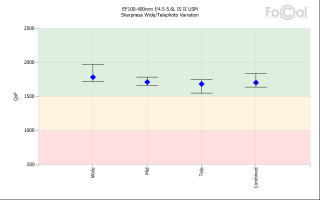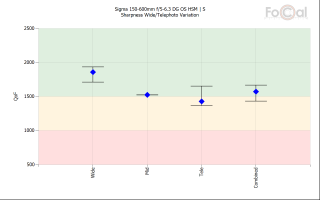bluenoser1993 said:
OK, once again I'm not completely sold on the comparability of the results. I was focusing more on my 100-400II with poor and better technique, but in getting ready to use my 135L this weekend I looked back at the test results. I had only paid attention to the AFMA setting at near and far distances, which only changed by 2. However, at 3.3m distance the QoF was 1520 and at 10.7m distance the QoF was 1820. Tested within minutes with the same lighting, target, setup, etc on my 5Ds. I don't have access to FoCal's data base, so don't know how this compares to the average range, but it does demonstrate how much spread is possible with the same camera, lens, target, lighting at different distances. It would appear that the algorithm has overcompensated for the softer image result because of the longer range, at least in this case.
Rich, I was doing this intentionally to see the AFMA required for longer range work and using my camera in crop mode. Because of the calculated distance, would this be a result that wouldn't make it into the data FoCal shares?
EDIT to change 10.3m to 10.7m, shouldn't have trusted my memory.
Just to demonstrate that this isn't a sample of one, the results with the 1.4X attached show the the same. At 4.7m the QoF is 1450 and at 10.7, the QoF is 1600.
So with all the same test conditions, my body and lens score a better QoF with the 1.4X attached at 10.7m than it does as a bare lens at 3.3m.
Again, these distances were not chosen to compare QoF, the 25x = 4.7m for standard use and the 50x plus 1.6 crop factor = 10.7m for long range use to determine if custom AFMA settings were required. I just mention it because the QoF results seem pertinent to this discussion.
EDIT: I PM'ed Rich my serial number and test date/time in case it would allow him to look up my tests and add any insight to the results and hopefully post them here.
EDIT: changed the near distance with 1.4x attached to 4.7. I shouldn't post so late at night!!


